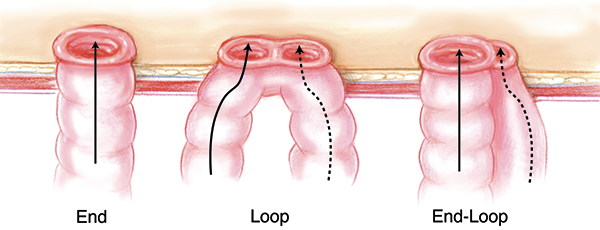When the temporary stoma is no longer needed, it can be reversed. The time from creation of a temporary ostomy to closure can vary from six weeks to six months. This period allows the patient to recover from their previous surgery, time for the stoma to mature, and scar tissue to soften making the subsequent operation easier. The time chosen will vary among surgeons and on the patient, their disease process, and treatment.
If the initial surgery was hard or there was significant infection or inflammation, a longer recovery time is preferred. If the patient needs chemotherapy, some surgeons prefer to wait until the patient’s chemotherapy is completed before the stoma is closed. Others, including this author, prefer to close the stoma before chemotherapy is given.
Reversal of a loop stoma is usually referred to as a stomal closure, while reversal of an end stoma is often referred to as a stomal takedown. A stomal closure is usually a much smaller operation than a stomal takedown. With a loop stoma, both ends of the bowel are attached to the skin, so the surgeon only needs to detach the bowel (stoma) from the skin using a scalpel or electrocautery and then divide any adhesions of the bowel surface to the subcutaneous fat and abdominal wall muscles. This is usually done with scissors or electrocautery. Once the bowel limbs are freed, the ends of the bowel can be reconnected or anastomosed. This anastomosis is done with staples or sutures. The different types of anastomosis are described in Figure 2.
Most surgeons use a side-to-side function, end-to-end type when they close a loop stoma. The reconnected bowel is then dropped back into the abdomen and the muscles of the ostomy site are closed with sutures. The skin and subcutaneous tissue can then be left open, partially closed, or closed with sutures or staples. The author prefers to partially close the skin. This reduces the time required to heal and lessens the chance of infection. The operation usually takes less than an hour.










